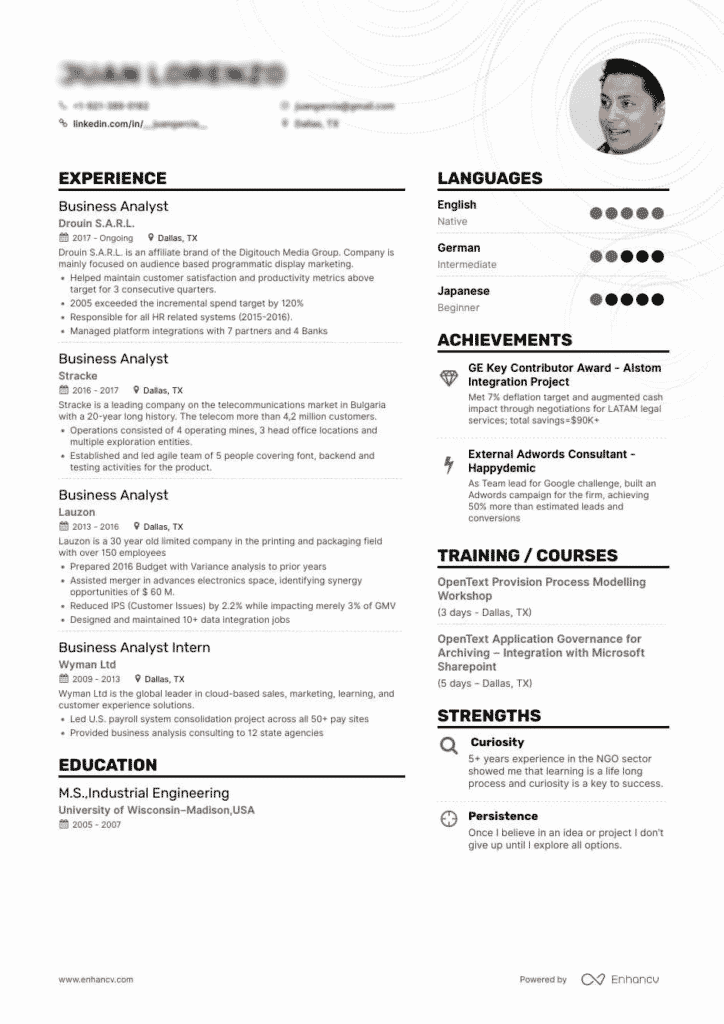The role of a business analyst revolves around analyzing data for performance, forecasting results, creating business intelligence, solving business problems, and suggesting improvements. All this is done using various different tools and technologies, hence professionals need specialized skill sets for this role. Also, business analysts play an important role in a company’s growth. Owing to all these factors, organizations always lookout for highly skilled professionals, and for you to grab a business analyst job you will have to present yourself to these organizations in the best light possible.
In this blog, we will guide you through the art of crafting a compelling business analyst resume, equipped with industry insights, sample resumes, and key factors that will help you stand out amidst fierce competition and land your dream job as a trusted advisor in the world of business analysis. Here, the importance of a well-drafted business analyst resume comes to light.
In this article, we will talk about how to create a perfect business analyst resume for your next job interview. Let us start with some important tips.
Tips to Write a Business Analyst Resume
- Pick the right combination of technical and soft skills that are relevant to the role you are applying for.
- Do not clutter the resume with text, leave some white spaces.
- Use bullet points and shorter sentence rather than long paragraphs.
- Use a direct, crisp, and relevant objective.
- Do not shy off from detailing into your experience.
- Mention all achievements, small and big.
What to include in a Business Analyst Resume
When you’re working on creating the perfect resume, it is important to know what to include in the resume. We’ll be listing a few important sections that you must incorporate in the resume.
- Work Experience
- Educational Qualification
- Contact Information
- Skills
You can also add the following:
- Certificates/Certifications
- Awards Received
- Interests and Hobbies
How to Write a Business Analyst Resume
In this section, we will look at:
- The format and structure of the resume
- How to write the header/ objective/ summary of the resume
- The experience section
Business Analyst Resume Format
While creating a resume, your goal should be to explain all the intricate details about your work experience, at the same time ensuring that the resume is not text-heavy. Hence, the best format to go for is either a reverse-chronological or combination resume.
A reverse-chronological resume describes your experience in the order of latest first and then moving back in time for every previous position. In a later part of this blog, we’ll discuss more about the perfect resume format.
The flow of the format is:
- Header
- Personal Summary
- Experience
- Skills – Technical and soft skills
- Education
- Achievements/ Certifications/ etc.
Pro tip – This format is suitable for those who have been working in the domain of business analytics for quite some time and have a great experience to showcase.
On the other hand, a hybrid resume places equal focus on career history and skills. With the help of this format, you can highlight transferable skills that would be relevant for the role you have applied for. Also, if your latest experience doesn’t seem to i=be immediately relevant to the role, then this is the right format.
Different Sections of a Business Analyst Resume
Header
To make the header instantly grab the recruiter’s attention, customize your e-mail, job title, LinkedIn URL, etc.
For example:
- Financial Business Analyst not Business Analyst
- A good Linkedin URL could be www.linkedin.com/”name”financialanalyst
Business Analyst Resume Summary
Including notable achievements in your summary is a good practice. The achievement should be measured and presented in a short and crisp format, clearly showcasing the value you would be bringing to the organization if hired.
Here’s an example of a good business analyst resume summary:
“Business Analyst with five years of experience in the medical supplies and equipment industry. Achieved 10 to 20% savings in inventory purchases after optimizing warehouse operations and analyzing the company’s fast-moving products.”
Source: https://enhancv.com/
Pro tip – Business analyst role differs from one industry and organization to another, hence specificity in writing a summary is important to showcase more value towards each role you apply for.
Experience
Here are a few things you need to keep in mind when writing the experience section of your resume:
- Use a mix of jargons and layman’s terms so that everyone, right from a recruiter with a set of keywords and skills pertaining to the role, to a manager who completely understands the role and requirement can easily browse through your resume.
- Show your range of work across departments and industries and the notable impact of your role on the department’s and organisation’s performance.
- Show results and tangible outcomes achieved by your efforts in previous organisations, such as:
- percentage improvement in output or productivity of a warehouse
- Increase in sales numbers of frontline sales teams
- A decrease in surplus of a supply chain or retail business
- Showcase your expertise if you specialise in a specific function or industry and applying for a job in the same area
How to Format a Resume
Having a clear and easy-to-read format plays an important role in the recruiting process. Showcasing your skills and work experience is important, but having the right format will make it easy for the recruiter to see the best features. A messy resume will surely not help you stand out from the crowd.
One of the most commonly used resume formats is the “reverse-chronological” resume format.
The reverse-chronological resume format displays your most recent work experience first and then lists the previous work. It works in a backward manner. This is the perfect way to show progress and highlight your journey so far.
Other resume formats that you can consider are the functional resume or the combination resume. A functional resume helps you focus on your skills in case you have a gap in your employment history, whereas a combination resume helps you highlight both skills and work experience. It acts as a combination of the reverse-chronological format and the functional format.
Here are a few more tips to keep in mind to help the resume look professional:
- Length of the resume: One page
- Font: Choose a font that is professional
- Line Spacing: Make sure to use a 1.5 or 1.0 line spacing
- Margin: There should be a one-inch margin on all sides of the resume
Pro tip – A hybrid resume is a perfect choice when transitioning to a business analytics career from a different domain.
Business Analyst Resume Sample
Now that you have seen a few tips on how to write a business analyst resume, seen the best format, and what to include in a resume, here’s a business analyst resume sample that can help you visualize the same.

Business Analyst Sample Resume
Business Analyst Skills
When it comes to skill sets that are important to become a business analyst, we should not be just talking about the technical skills, soft skills are equally important.
The most crucial skills that should be acquired before applying for business analyst jobs are:
- Communication Skills
- Technology skills such as MS Office, Microsoft Visio, Software design tools, SQL, Business process models, etc.
- Data Visualisation and Statistical Analysis
- Financial Planning Techniques
- Problem-solving skills
- Time Management
- Documentation and Reporting
- Research Skills
- Managerial Skills and Decision Making
- Attention to Detail
- Creative Thinking
- Gap Analysis
- SWOT Analysis
- Risk Analysis
- Benchmarking Skills
- Knowledge about Analytical Softwares
Various tools come in handy for the day-to-day functioning of a business analyst. These are:
- Project Management Tools like Jira, Asana, and Trello
- Documentation Tools like Confluence and DokuWiki
- Modelling Tools draw.io, LucidChart, Microsoft Visio
Key Factors for Landing Your Dream Job
- Showcase Business Analysis Skills: Highlight your proficiency in business analysis techniques such as requirements gathering, stakeholder management, process mapping, and gap analysis. Demonstrate your ability to translate business needs into actionable insights.
- Emphasize Data Analysis and Visualization Skills: Showcase your expertise in data analysis tools like SQL, Excel, and visualization tools like Tableau or Power BI. Highlight your ability to derive meaningful insights from complex datasets and effectively communicate them through visually engaging dashboards.
- Highlight Project Management and Change Management Experience: Showcase your familiarity with project management methodologies like Agile and your ability to manage change and drive adoption within organizations. Highlight your experience in facilitating collaboration and fostering positive relationships with stakeholders.
- Demonstrate Domain Knowledge: Highlight your understanding of specific business domains such as finance, supply chain management, CRM, or e-commerce. Showcase your ability to apply your business analysis skills within the context of these domains.
Points to Keep in Mind While Writing a Resume
- Read the job description carefully and align your resume as per the job you are applying for
- Use the correct format and do not overfill the resume with text
- Position yourself as the best choice for the job requirement and flaunt all your achievements backed by numbers and results in your previous stints
- Do not forget to mention soft skills along with your technical expertise
- Highlight your achivements rather than daily tasks
- Make use of a cover letter than is convincing enough to the recruiter
- Keep the attention of the reader by creating an engaging resume
A major factor of building a great resume is showcasing relevant skills that allow the recruiter to know that you are the right individual for the job. You can improve your resume by learning the most in-demand skills with online courses & certificates that will help you kick-start your career and help your resume stand out.









